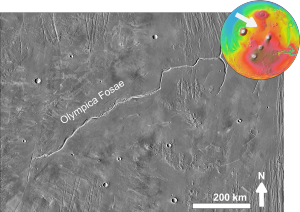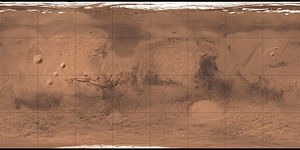Olympica Fossae
| Digging on Mars | ||
|---|---|---|
| Olympica Fossae | ||

|
||
|
|
||
| position | 26 ° 56 ' N , 22 ° 56' E | |
| surface | 420 km² | |

Olympica Fossae is a trench in the Tharsis region of Mars at latitude 25 ° north and longitude 114.1 ° west. The formation is 420 km long and was named after a point with a special albedo (reflectivity) at 17 ° north latitude and 134 ° west longitude.
Fossa
Olympica Fossae is an elongated moat, called a fossa in astrogeology . Such trenches are formed when the earth (Mars) crust is stretched so much that it breaks. Such a trench has two fault zones, between which the intermediate material subsides. This leads to steep cliffs diverging from each other.
Dark Slope Streaks (Dark Stripes)
Dark streaks on slopes are common on Mars. They appear on steep slopes of craters, troughs, and valleys and get lighter with age. Sometimes they start in a small point-like area and then get progressively wider. They were observed to move around obstacles such as hollows. The color is believed to come from dark underlying layers exposed by avalanches of light dust. However, other hypotheses have also been made, such as water or even the growth of organisms. The most interesting thing about these Dark Slope Streaks is that they are still forming today. Most of the Martian atmosphere is filled with fine dust. This dust settles after it is blown up and covers practically everything. Today we know relatively well about this dust due to the fact that the solar modules of the Mars rovers are often covered by dust, which then leads to a decrease in the performance of the rovers, as it can no longer absorb enough solar energy. Nevertheless, the performance of the rovers is often restored by the wind, especially in the form of dust devils , which remove dust from the solar modules. Dust storms are very common on Mars, especially during spring in the southern hemisphere. At this time, Mars is 40% closer to the Sun, as Mars' orbit around the Sun is much more elliptical than Earth. Furthermore, global dust storms occur on Mars every few years. When Mariner 9 reached Mars, almost nothing could be seen on the surface due to a dust storm. Since then, several more global dust storms have been observed.
Web links
Coordinates: 25 ° 0 ′ 0 ″ N , 114 ° 6 ′ 0 ″ W.
Individual evidence
- ↑ Olympica Fossae in the Gazetteer of Planetary Nomenclature of the IAU (WGPSN) / USGS
- ↑ Mars Global Surveyor MOC2-620 Release. In: msss.com. Retrieved February 10, 2017 .
- ^ Robert Roy Britt: Dark Streaks on Mars Suggest Running Water Still Present. SPACE.com, December 11, 2002, archived from the original on April 27, 2008 ; accessed on September 18, 2009 (English).
- ↑ http://www.sciencedaily.com/releases/2009/02/090217101110.htm. In: sciencedaily.com. Retrieved February 10, 2017 .
- ^ Patrick Moore: Atlas of the solar system . Crescent, New York 1990, ISBN 0-517-00192-6 .
- ^ Hugh H. Kieffer: Mars . University of Arizona Press, 1992, ISBN 978-0-8165-1257-7, (accessed March 7, 2011).
